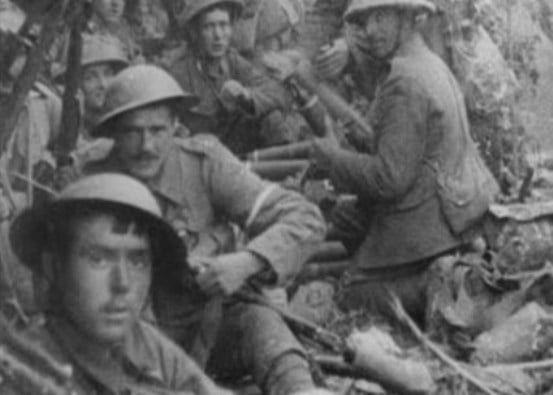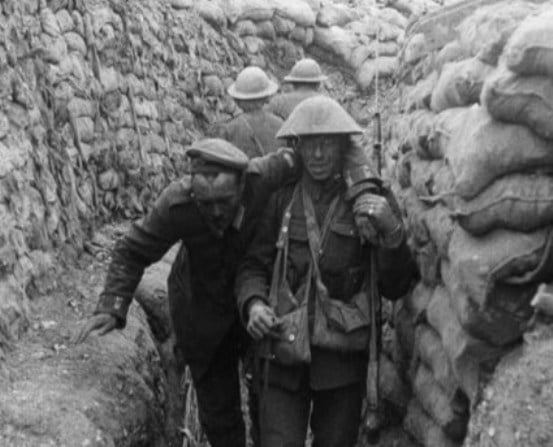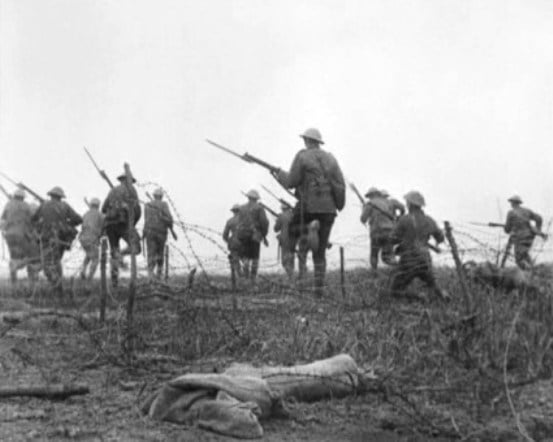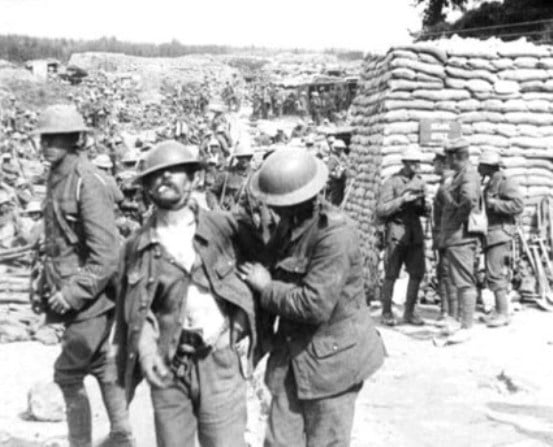Is it right to let us see men dying? Yes. Is it a sacrilege? No. If our spirit be purged of curiosity and purified with awe the sight is hallowed. There is no sacrilege if we are fit for the seeing … I say it is regenerative and resurrective for us to see war stripped bare. Heaven knows that we need the supreme katharsis, the ultimate cleansing. We grow indifferent too quickly … These are dreadful sights but their dreadfulness is as wholesome as Tolstoy’s ‘War and Peace’. It shakes the kaleidoscope of war into human reality … I say that these pictures are good for us.
Those words were written by James Douglas in The Star (25 September 1916, p. 2). He was reacting to a screening of the film The Battle of the Somme, a film whose impact upon audiences was unprecedented and – it could be argued – has never been repeated. Douglas, like many commentators, was trying to rationalise what he saw, to express the meaning and to find justification for a film whose stark images of the war that was still raging shocked audiences into a realisation of sacrifice and death. It was the images of death in the film that so disturbed many. If soldiers were not shown being killed (and some apparently were), then every face that stared at the camera was likewise facing death. The audience had been made witness to this, complicit in the soldiers’ fate.
While some called for the film not to be shown, for most it was justified, to the point of becoming almost a moral obligation. Through watching The Battle of the Somme, they gained a sense of the enormity of what troops in their name were undergoing, what the sacrifice (the optimum word) was that army and nation were making. Douglas’ evocation of religious feeling put the film in terms that many would understand. It is not a pure reaction to the film itself – that is not possible. Instead he saw the film through his own thoughts on the meaning of war. Any image, any film, is identified by us through expectations and understandings that are informed by time, place and culture. The Battle of the Somme in 1916 was a different film to The Battle of the Somme in 2008.
This we can now judge through the release of the film for the first time on DVD, produced by the Imperial War Museum, whose archive preserves the film. Alert to the complexities of authenticity, the IWM presents the film in a form that encourages us to question how we see what we see. Firstly, the film (for which no original negative survives) has undergone a digital restoration which has brought out details which were hitherto obscured. Even for those familiar with the film (and all of us must be familiar with it to some extent, given the widespread use of sequences from the film in television documentaries etc.), it is like seeing the film anew. But the major coup is the music. We are given two music tracks. One is a modern score by Laura Rossi, a symphonic work for full orchestra. The other is a recreation by Stephen Horne of a likely original score, taken from a contemporary cue sheet which suggested the sort of musical passages musicians might want to adopt in accompanying the film in 1916.
The latter will amaze many. Jaunty marches and popular airs accompany scenes of troops marching to the killing fields of the Somme, the scenes of battle and their aftermath. What were they thinking of in 1916? It is a complicated question to answer. Partly the musicians of the time were responding to what might have seemed just another war actuality film, which required patriotic accompaniment. But also the audience of the time saw heroism and uplift where we, after almost a century of awful contemplation of the futility of that war, bolstered by poems, novels and films, see something profoundly pitiable. It is with consciousness of such modern expectations, but equally with a sense of being true to the film’s original vision, that Rossi supplies a rich, subtle and binding score that connects 2008 to 1916. Which of these two very different scores will you prefer to listen to, and why? Or might your preferred option be to witness the film in silence?
The digital restoration, which allows us to see so much, is perhaps most striking when it comes to the famous ‘over the top’ sequence. This is the part of the film that will be most familiar. It is shown on television (at least in the UK) every time a shot is needed to evoke the First World War. Troops clamber over the top of a slope, then march slowly over barbed wire away from the camera, a couple of men falling down as they do so, shot dead.
Oh God, they’re dead!
a woman is reported to have exclaimed in a cinema showing the film, and it was this sequence that aroused the greatest comment at the time, the greatest need to explain the film’s significance. But they were not dead. As is now known, the sequence is a fake, set up in a trench mortar battery school some time afterwards, simply because the actual scenes taken of troops going over the top were deemed disappointing. At the time, no one knew of this subterfuge, and as far as reception is concerned, it did not matter. People believed they were witnessing death on screen; and producers and exhibitors felt this to be an acceptable thing to show. Which you may think is extraordinary.
What seldom gets shown on television is the shot that immediately follows the ‘over the top’ sequence in the film. This shows genuine footage of troops going over the top. But we see them only in the far distance. The cameramen (there were just two, J.B. McDowell and Geoffrey Malins, who shot both ‘over the top’ sequences) were greatly restricted in what they could shoot. Their hand-cranked cameras had single 50mm lenses with poor depth of field, they had no telephoto lenses, the orthochromatic film stock was slow, making filming action in the distance or in poor light difficult. But there was also military control and official censorship, each preventing them from filming anything other than officially-sanctioned images. And there was the danger. The most obvious indication of the ‘fake’ nature of the first sequence is that the cameraman would have been in absolute peril of his life had it been genuine. But for the above shot, Malins is a long way off, and far in the distance we can just pick out tiny figures on the horizon – British troops, coming over the top and marching into no-man’s land. Looking closer into the middle ground, the digital restoration now reveals to us a sight not previously detected in the film: a number of troops proceeding leftwards, one or two of whom fall down. Oh God, they’re dead.
Do we want to look that closely? Can they really seem dead when viewed at such a distance? Is the death we seek not in the falling bodies, or even in the corpses seen later in the film, but rather in the eyes of the still living, whose fate awaits them, and who are all dead now of course. That was a line the film historian Denis Gifford would sometimes come out with when we were in the basement theatre at the British Film Institute, watching some collection of British silent shorts. The figures would parade to and fro, some of whom he knew, having interviewed them in the 1960s, but then that sad moment of realisation:
They’re all dead now, of course.
This is a poignancy that seems particularly linked to the non-fiction film. Dramatic films, of whatever age, are attempting to entertain. Either they do or they don’t. But the film of actuality trades on the depiction of life, and then the distance created by time. This was recognised even in 1916. Sir Henry Newbolt wrote a poem inspired by the experience of watching the film, entitled ‘The War Films’, but made memorable by its opening line:
O living pictures of the dead,
O songs without a sound,
O fellowship whose phantom tread
Hallows a phantom ground —
How in a gleam have these revealed
The faith we had not found.
The Battle of the Somme captures the point of loss, the ghosts on the screen, the living pictures of the dead. Of course it is a deeply partial record. It shows no real fighting beyond shellfire, no serious injuries, no pain, little hatred (look for the shove that one British soldier gives to a captured German who stumbles past him). And of course it shows only the Allied point of view (the Germans would respond with their own film, Bei unseren Helden an der Somme, in 1917). But we recognise it for what it is able to show, not for what it leaves out. It is a profoundly memorably expression of the hopes and fears of its age.
The Battle of the Somme was filmed by Malins and McDowell, two experienced newsreel cameramen, who knew well how to capture plain packages of actuality. McDowell was the senior of the two, who ran his own film company (British & Colonial). Malins had been filming on the war front for longer, and is the better known, not least for his somewhat vainglorious memoir, How I Filmed the War (available from The Internet Archive). Malins co-edited the film with Charles Urban, to whom credit should be given for seeing that the footage Malins and McDowell has shot would work best at feature length, rather than as a series of ten-minute shorts which had been the practice up til then. His vision gave the film the presence it needed to capture the audience that it found. The producer was William Jury, and the film was made for the British Topical Committee for War Films, a trade body working under War Office sanction, which would be replaced by the War Office Cinematograph Committee once the film started to enjoy huge success. It has been estimated that it was seen by 20,000,000 people in the UK in six weeks – almost half the population.
The DVD comes with the alternative music scores, commentaries, interviews with archivists and musicians, and five ‘missing’ scenes and fragments. We do not know what the original The Battle of the Somme was like exactly; the version that survives was re-edited, and the footage used in multiple other films, during and after the war. Rather than insert these extra scenes where it is not quite certain they should go, the IWM has chosen to present these (without music) separately. There is a booklet as well, with information on the film’s production, reception, restoration and particularly its music. A website, www.iwm.org.uk/somme-film, will provide viewing notes, additional information, suggestions for further reading and teaching resources [site no longer active]. It is a magnificent achievement, one whose influence on research, teaching and the appreciation of First World War history is likely to be considerable. The only possible disappointment is the menu, which simply divides the film into its five parts, where a more detailed use of chapters could have helpfully guided researchers to particular points of action, regiments, location etc.
More will follow. The booklet notes the publication next year of Alastair H. Fraser, Andrew Robertshaw, and Steve Roberts’ Ghosts on the Somme, a book which analyses the film in great detail, overturning some of the traditional understanding of who filmed what, which regiments are shown, and which locations are featured, while confirming that the vast majority of the film is genuine actuality. There is still more to be discovered about The Battle of the Somme. It is a film we will have to return to, again and again.
The DVD is available from the Imperial War Museum Shop (Region 0, PAL, duration 74 mins with 58 mins extras). All images in this post are frame grabs from the DVD. A CD of Laura Rossi’s score is available from Virtuosa Records.
The Battle of the Somme has been recognised by UNESCO by being accepted for inscription on its Memory of the World register.
Note: Originally published on The Bioscope 1 November 2008 and reproduced here with some small emendations.





